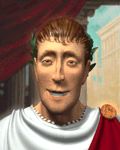The Romans |
|||||||||||||||||||||||
| Profile | |||||||||||||||||||||||
|
|||||||||||||||||||||||
|
Roman Cities
Great Leaders
|
Background
The founding of Rome on the fertile Tibur River is obscured by myth and legend, but it is generally accepted that Rome was first settled in 753 BC and that the Republic was founded in 509 BC, following the overthrow of Lucius Tarquinius Superbus, the last of Rome’s seven kings. Rome was built on a site highly prized by the Etruscans, who dominated the Italian peninsula in the 6th century BC. The Etruscan king Porsenna defeated the Romans and expelled Tarquinius Superbus. Yet before Porsenna could establish himself as monarch over the unruly Romans, he was forced to withdraw. Rather than restoring their inept king, the citizens replaced the monarchy with two elected consuls, generals whose primary task it was to lead Rome’s armies, and a Senate to serve as an advisory body. Where the Etruscans had failed, the people of Rome succeeded in the task of unifying the various Italian peoples into a political whole. Toward the end of the 5th century BC, the Romans, propelled by the pressures of unchecked population growth, began to expand at the expense of nearby city-states. Rome’s first two wars were fought with Fidenae, an independent city near Rome, and against Veii, an important Etruscan city. In the process, the expanding Roman Republic found the Greek phalanx formation too unwieldy for fragmented fighting in the hills and valleys of central Italy; accordingly, Rome evolved a new tactical system based on flexible ranks of cohorts, organized into self-contained Legions, the means by which Imperial Rome conquered and ruled the ancient world. When Rome became increasingly powerful, the remaining city-states took up arms; the ensuing Latin War (340-338 BC) was quickly decided in Rome’s favor. By 264 BC all Italy south of the Alps was united under the leadership of Rome, its members either incorporated in or allied with the Republic. Rome’s growing influence led it into conflict with Carthage, an established commercial power in northern Africa. The defeat and destruction of Carthage in the three Punic Wars (264-146 BC) sustained Rome’s acquisitive momentum, and the Republic set its sights on dominating the entire Mediterranean area. In short order, the Romans overran Syria, Macedonia, Greece and Egypt, all of which had until then been part of the decaying Hellenistic empire created by Alexander the Great. But such expansion was not without costs; tensions grew and civil war erupted. The ensuing period of unrest and revolution marked the transition of Rome from a republic to an empire. The later stages of these civil wars encompassed the careers of the brilliant Pompey, the orator Cicero, and the consul Julius Caesar, the conqueror of Gaul (58-50 BC), who eventually was given power over Rome as its dictator. After his assassination in 44 BC, it was not long before civil war again erupted; but following his victory at Actium (31 BC), Octavian, Julius’ nephew, was crowned Rome’s first emperor, Augustus 27 BC-14 AD). Although there were exceptions such as Caligula (37-41) and Nero (54-68), Rome was blessed with a series of able and brilliant leaders who expanded the frontiers until Rome’s empire reached from Britain to Egypt and from Spain to Persia. Imperial Rome was distinguished not only for its military – the foundation upon which the empire rested – but also for its accomplishments in engineering and statecraft. The Romans were gifted in the applied arts of law, record-keeping and city planning, yet they also acknowledged and adopted the contributions of earlier peoples – most notably, those of the Greeks, much of whose culture was thereby preserved. Roman law was a complex body of precedents and opinions, which were finally codified in the 6th century as the Justinian Code. The empire’s road network was without match in the ancient world, designed for rapid movement of commerce, agriculture, mail delivery as well as the army. Roman city planners achieved unprecedented standards of hygiene with their plumbing, sewage disposal, dams and aqueducts. Roman art and architecture, though often imitative of Greek styles, was boldly planned and lavishly executed. Roman science and culture, in short, became the foundations of the European world. Unique Unit: the Legionary The Legionary is an upgraded version of the swordsman. Like the swordsman, it requires iron to build, but it has an additional defensive point, making it one of the most formidable defenders of the early and middle ages, on par with pikemen.
|
||||||||||||||||||||||

 The Romans are militaristic and commercial. They start the game with Warrior Code and Alphabet and build legionaries instead of normal swordsmen.
The Romans are militaristic and commercial. They start the game with Warrior Code and Alphabet and build legionaries instead of normal swordsmen.  Roman Legionaries were well trained, well equipped, and well paid. In fact, it’s a good thing they were paid so well, because Legionaries were required to pay for regular maintenance of their equipment out of their own pockets! Equipped with a short sword (gladius) or throwing spear (pilum), clad in steel plate armor and a bronze helmet, and wielding a large shield, a Roman Legionary was a fearsome sight indeed. Well-known for their offensive potency, Legionaries were equally adept at holding their ground, relying on clever defensive tactics and superior equipment.
Roman Legionaries were well trained, well equipped, and well paid. In fact, it’s a good thing they were paid so well, because Legionaries were required to pay for regular maintenance of their equipment out of their own pockets! Equipped with a short sword (gladius) or throwing spear (pilum), clad in steel plate armor and a bronze helmet, and wielding a large shield, a Roman Legionary was a fearsome sight indeed. Well-known for their offensive potency, Legionaries were equally adept at holding their ground, relying on clever defensive tactics and superior equipment.